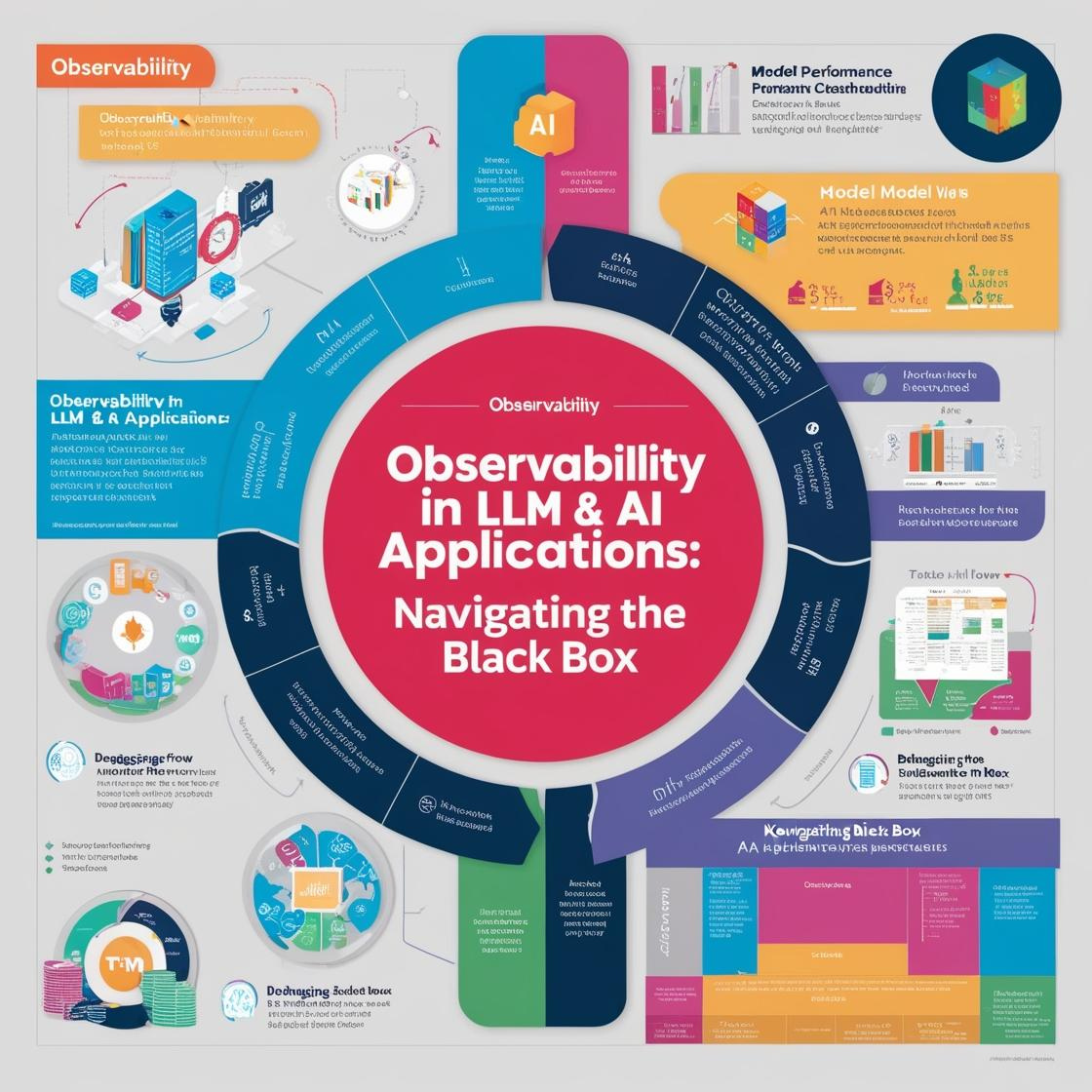Observability in LLM & AI Applications: Navigating the Black Box
 DurgaSaran
DurgaSaran
The explosive growth of Large Language Models (LLMs) and AI applications is reshaping industries, enabling capabilities from advanced chatbots to intelligent recommendation engines. However, these advancements also introduce unique challenges for system observability, as traditional monitoring methods often fall short. When applied to AI, monitoring requires a shift to track not just performance metrics but also complex behaviors, resource usage, and interdependencies that traditional applications don’t exhibit. This blog explores the nuances of LLM observability, the impact of insufficient monitoring, and best practices for building a robust, AI-aware observability stack.
The Challenge: Why LLM Observability is Different
LLM observability brings new complexities, fundamentally different from monitoring traditional applications. Below, we break down some of the core challenges.
1. Non-Deterministic Behavior
Challenge: LLMs often produce varying outputs even with identical inputs, unlike traditional systems where output is usually predictable for the same input.
Example: Consider an AI-driven support chatbot that responds differently to the same query depending on minor context changes. This variability complicates baseline performance metrics, as the model doesn’t follow a set "request-response" pattern.
Solution: Observability for LLMs must account for these variations by capturing a diverse range of response patterns, error rates, and potential anomalous outputs, making traditional static monitoring insufficient.
2. Complex Resource Utilization
Challenge: LLMs and other AI models have highly dynamic resource requirements, with GPU/CPU, memory, and network bandwidth usage often fluctuating during inference.
Example: High memory usage may peak during batch processing, while GPU utilization may vary depending on model loading or prompt processing phases. These fluctuations can lead to unanticipated spikes in cloud costs.
Solution: Implement resource utilization monitoring that dynamically adapts to workload demands, capturing peak usage and under-utilization for optimization insights.
3. Multi-Layer Dependencies
Challenge: AI systems depend on a complex stack, from model-serving infrastructure to prompt engineering, making it difficult to pinpoint performance bottlenecks.
Example: A malfunction in vector database indexing may slow down retrieval, impacting model inference speed. This multi-layered system can mask root causes, with dependencies spanning APIs, embeddings, and data pipelines.
Solution: Observability tools need to capture these dependencies in real-time, offering visibility across the infrastructure, API gateways, model servers, and embedding services.
Business Impact of Poor Observability
Lack of robust observability for LLM systems impacts businesses in multiple ways, especially with regards to finances, operations, and compliance.
Financial Implications
Unexpected Costs: AI workloads with poor observability may incur unexpected cloud expenses from unoptimized resource consumption, causing budget overruns.
Revenue Loss: Service degradation, like response delays or accuracy issues, can lead to customer dissatisfaction, potentially reducing revenue in sectors relying on customer experience.
Hidden Technical Debt: Unmonitored issues can create “invisible” technical debt, with costly fixes needed when underlying inefficiencies become unmanageable.
Operational Risks
Model Drift Detection: Without observability, detecting when an LLM’s performance changes (model drift) is difficult, impacting its effectiveness.
Capacity Planning: Observability helps teams estimate and scale resources for growing workloads. Insufficient observability complicates this, leading to over- or under-provisioning.
Compliance and Audit Challenges: In regulated industries, maintaining observability ensures traceability of model behavior, vital for audits and regulatory compliance.
Building an Observable LLM Stack
Creating an observable stack for AI requires integrating both traditional observability tools and AI-focused monitoring solutions.
1. Foundation: eBPF Integration
Kernel-Level Visibility: Extended Berkeley Packet Filter (eBPF) technology provides insights directly from the OS kernel, capturing low-level data without significant overhead. For AI workloads, this means:
Real-Time Bottleneck Detection: Track system calls and network performance, useful for spotting latency issues.
Resource Utilization: Monitor real-time GPU, CPU, and memory usage patterns at a granular level.
Application Performance Monitoring: eBPF allows function-level tracing, useful for:
Latency Tracking: Measure latency across different model calls.
Memory and GPU Utilization: Detect high-load patterns during peak inference loads to optimize resource allocation.
2. OpenTelemetry Implementation
Distributed Tracing: Track each request’s journey through the system, enabling teams to measure latency between different components like model servers and API gateways.
Metrics Collection: Capture AI-specific metrics such as inference times, token usage, and error types.
Logging Infrastructure: Structured logging enables monitoring of both prompt inputs and outputs, error rates, and model performance.
Getting Started with LLM Observability
Implementing observability for AI should be done iteratively, starting with foundational monitoring and progressively advancing.
Phase 1: Basic Monitoring Setup
Define Key Metrics: Begin by monitoring core metrics like response latency, token consumption, error rates, and resource usage.
Implement Basic Telemetry: Set up basic OpenTelemetry and eBPF monitoring, focusing on establishing baseline performance metrics.
Phase 2: Advanced Observability
Custom Instrumentation: Create custom metrics to capture model-specific KPIs such as cost per query or business outcomes.
Automated Analysis: Utilize anomaly detection and prediction models to forecast resource needs and optimize costs based on usage patterns.
Phase 3: Continuous Improvement
Feedback Loops: Implement user feedback to assess satisfaction and adjust model parameters. A/B testing can help understand user responses to model variations.
Integration with DevOps: Establish automated alerts and incorporate observability metrics into CI/CD pipelines for real-time feedback on performance regression.
Best Practices for LLM Observability
Maintaining robust observability for AI applications requires adopting several best practices to ensure data relevance and usability.
1. Data Collection
Sampling Strategies: Avoid overwhelming your system by sampling relevant metrics; employ techniques like stratified sampling to ensure diverse data points.
Data Privacy: Ensure compliance by anonymizing user data where needed, particularly with prompt logging.
2. Visualization and Analysis
Custom Dashboards: Set up stakeholder-specific dashboards. Engineers may need real-time system performance, while product managers focus on business KPIs.
Automated Reporting: Use tools like Grafana to send regular reports, helping teams understand trends and act on issues proactively.
3. Alert Design
- Actionable Alerts: Define thresholds to avoid “alert fatigue.” Alerts should provide actionable insights, like pinpointing specific model layers or services responsible for latency.
Open Source Tool Stack
The following tools help build a powerful observability stack tailored for LLMs:
Monitoring and Metrics: Use Prometheus for collecting metrics, Grafana for visualization, and Jaeger for distributed tracing to provide visibility across layers.
System Analysis: eBPF tools like bcc-tools for kernel-level insights, Vector for log processing, and OpenTelemetry Collector for telemetry data aggregation.
Storage and Analysis: Elasticsearch for storing logs, Kibana for log analysis, and InfluxDB for time-series data storage.
Conclusion
Observability in LLM applications demands a blend of traditional monitoring and AI-focused metrics to truly understand system performance. By leveraging open-source tools like eBPF and OpenTelemetry, organizations can establish observability pipelines that capture insights at both technical and business levels. Success in this space hinges on starting small—focusing on essential metrics—and expanding the observability surface gradually. Continuous adjustment and feedback help observability efforts evolve alongside AI applications, supporting system reliability and business value.
Subscribe to my newsletter
Read articles from DurgaSaran directly inside your inbox. Subscribe to the newsletter, and don't miss out.
Written by

DurgaSaran
DurgaSaran
Enthusiastic Technical Consultant specializing in DevOps, Data Engineering, and Security. Adept at designing and implementing Observability solutions for real-time insights for Enterprises. Proven track record in optimizing cloud infrastructure for enhanced performance and security.